Introduction
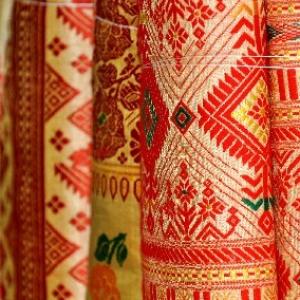
The Northeast is a hub of colorful textile production and each thread and pattern carries stories deeply rooted in their cultural identity. In this regard, Assam is renowned for its rich silk-weaving heritage, particularly the production of Muga silk, which is often celebrated as the ‘golden treasure’ of the region. Muga silk is one of the rarest silks in the world and is exclusively found in the state of Assam. Known for its lustrous golden color, this fabric is elegant and luxurious.
Origin of the textile
Throughout the course of a millennium, silk weaving has been mentioned in ancient writings, travelogues, and regional chronicles. Silk weaving is rooted in the cultural and rural life of the Assamese people. Here, the word “Muga” literally translates to “yellowish brown colour,” which describes the fabric’s golden tone.
Historically, Muga silk is associated with wealth and royalty with sources revealing its connection to the Ahom dynasty (1228 CE-1828 CE). The production and cultivation of Muga silk were encouraged by the royals and aristocrats, which contributed to the rise in popularity and skill of numerous silk rearers and weavers. During the Ahom era, high-ranking officials, kings, and queens wore robes and garments made of Muga silk whereas commoners wore attire made of cotton or other coarse varieties of silk.
The royal households owned silk looms and employed skilled weavers to manufacture muga garments; mostly women weavers were brought from different parts of the state. Often referred to as “Rajagharia” looms or royal looms, these looms created distinctive muga fabrics for royal use, which were then kept in the royal storehouses for display to foreign dignitaries. In addition to this, the Ahoms promoted their trade in the markets of modern-day Tibet, Bhutan, Myanmar, and the Gangetic plains, and also gave muga silk robes to other courts.
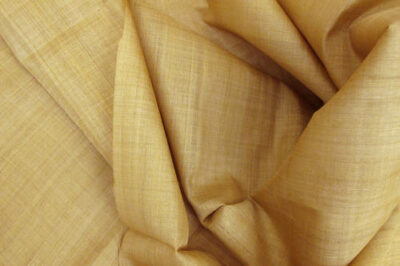
Flourishing of the Muga silk in Assam

At present, Assam contributes 95% of the country’s total muga silk production. Apart from muga, two other types of silk are also popular—eri and mulberry silk. Around 9500 sericulture villages in the state of Assam produce muga, eri, and mulberry silk, and among them, ‘Sualkuchi’ is the most important center for the production of muga silk. Located on the north bank of the Brahmaputra, Sualkuchi is the largest weaving village in Assam, where most of the households there are engaged with commercial weaving, significantly supporting the handloom industry.
Muga silk is more than simply a fabric; it is an integral part of Assamese culture and is used to weave traditional clothing like the gamusa, mekhela chador, and headdresses, as well as stylish sherwanis and kurtas. Muga silk is worn at weddings, religious ceremonies, bihu celebrations, and other auspicious events because it is seen as a symbol of purity.
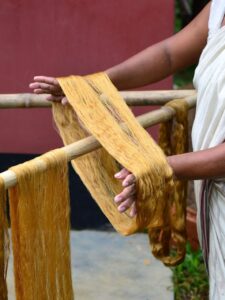
How is the Muga silk cultivated?
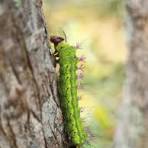
Growing muga silk is a painstaking process that calls for the highest level of expertise, accuracy, and above all, patience at every turn. The silkworm from which muga is derived is known as ‘Antharaea assamensis,’ a worm indigenous to the state. These worms feed and grow on trees called the som (Machilus bombycina) and the soalu (Litsaea polyantha), through which they spin and develop golden-colored cocoons around themselves. After this, the cocoons are harvested in a careful manner, ensuring not to harm the moth inside. Silk threads are then extracted after boiling the cocoons and separating the fiber.
Once the golden, glossy yarn is extracted, it is sold to places where it is woven into finished clothing by weavers using the handloom—most particularly the traditional Muga mekhela chador.
Elaborate motifs of the Muga mekhela chador

A timeless statement for grace, traditional Muga mekhela chadors from Assam are embellished with a wide range of designs that highlight the region’s natural and cultural heritage. Animal, bird, and human abstract images, as well as celestial symbols like the crescent moon (joon-biri) are frequently used designs. Animals like deer, rhinoceroses, and bulls are usually depicted.
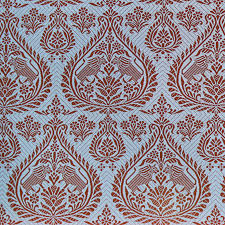
Alongside the ever-popular paisley design, nature-inspired motifs such as lotuses, jasmine, creepers, ferns, and leaves are extensively featured. While traditional cultural icons like the dhol (drum), pepa (buffalo horn pipe), and jaapi (traditional bamboo hat) are commonly seen, regal themes like the kingkhap, which depicts two lions facing one another, provide a touch of grandeur steeped in Assam’s heritage.

Spotlight on the Muga silk—its relevance in popular culture

This golden textile has gained significant recognition on the global stage. Renowned fashion designers and celebrities have customized and donned the Muga silk sarees, bringing Assamese craftsmanship into the global spotlight.

In recent times, Muga silk was proudly displayed by an Assamese film artist at the prestigious Cannes Film Festival, further elevating its status. Globally, Muga silk is exported to various countries, with Japan particularly purchasing it to make exquisite kimonos, curtains, blankets, and other items.
Challenges and current status of the Muga silk
Muga silk faces several setbacks despite being one of the most environmentally friendly and organic textiles. Climate change is a major concern because Muga silkworms are highly susceptible to temperature changes. As a result of growing land expansion for residential and industrial settlement, many Som and Soalu trees are being cut down, which is crucial as they are the main host plants for the silkworms. Moreover, the growing shift towards indoor silkworm cultivation often compromises the quality traditionally achieved through outdoor farming.
Traditional Muga growers and weavers have been negatively impacted by the influx of cheaper and low-quality silk materials into the market. By undermining the authenticity, skill, and labor put forth by generations of artisans, these duplicate silk goods significantly lower the value of real Muga silk.
Addressing the challenges faced by the Muga silk industry requires certain initiatives and support. Important steps have been taken to protect and advance the sector by state and government organizations like the Assam Silk Outreach Mission Society and the Central Silk Board. Muga silk was also granted a Geographical Indication (GI) tag in 2007, affirming its authenticity and recognizing it as a unique textile heritage of Assam. In addition to this, small-scale farmers and traditional weavers are also given financial assistance and incentives to boost their output. The youth must also engage themselves in learning about the craft in order to ensure its survival.
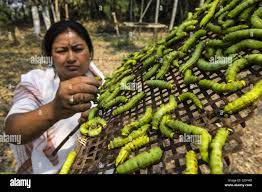
Conclusion
The Muga silk is an emotion of the Assamese people. A Muga mekhela, passed down from generations to generations, from mothers to daughters, is an heirloom as precious as any gold or diamond. Choosing to buy genuine Muga silk products, supporting traditional craftspeople, and spreading awareness are the ways in which we, as customers, can help preserve this legacy. Its preservation and continuation is necessary as it reflects the brilliance and legacy of Indian craftsmanship.
References
https://globaljournals.org/GJHSS_Volume12/2-Muga-Silk-Industry-of-Assam.pdf
https://www.iiad.edu.in/the-circle/muga-silk-weaving-golden-dreams/
https://indianculture.gov.in/stories/muga-silk




